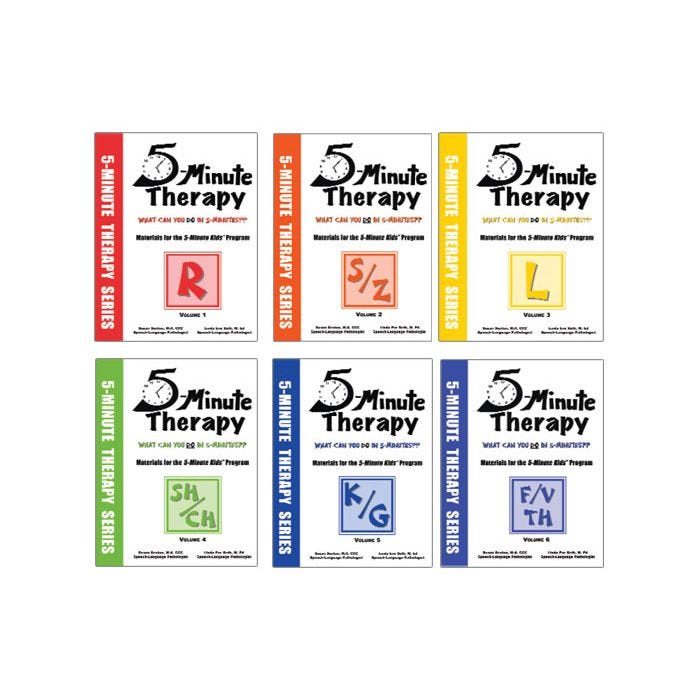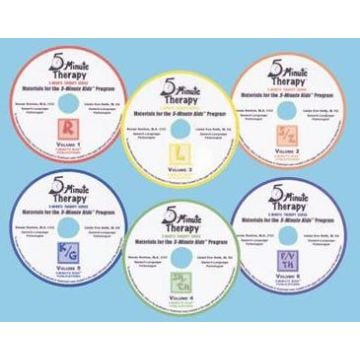5 Minute Therapy

| ITEM# | PRODUCT NAME | AVAILABILITY | PRICE | QTY/ACTIONS |
|---|---|---|---|---|
| 74499 | 5 Minute Kids Manual |
In Stock |
$43.99
|
|
| 74506 | 5 Minute Therapy Volumes 1 - 6 Bundle |
In Stock |
$133.99
|
|
| 74500 | 5 Minute Therapy Volume 1 - R |
In Stock |
$23.99
|
|
| 74501 | 5 Minute Therapy Volume 2 - S/Z |
In Stock |
$23.99
|
|
| 74503 | 5 Minute Therapy Volume 4 - SH/CH |
In Stock |
$23.99
|
|
| 74504 | 5 Minute Therapy Volume 5 - K/G |
In Stock |
$26.99
|
Product Description
Also available as also available 5 Minute Therapy CDs. Include games in your therapy with 5 Minute Games CD.
A necessary component of articulation therapy is the opportunity to practice speech sounds as many times as possible to achieve success. The 5 Minute Therapy program is clear, step-by-step program developed by a speech language pathologist to help children with speech sound disorders. The intent of this program is to minimize the amount of time that a child spends out of the classroom and to improve the quality of time that the child spends working on individual speech sounds in therapy.
The 5 minute individual session allows a child to practice speech sounds at least 50 to 100 times, in comparison with 20 to 30 time in traditional speech therapy. In addition to the increased time spent in the classroom, other advantages have been documented using this program. The speech pathologist has more opportunities to make up missed sessions because of the flexible schedule. Parents have stated that they are pleased because their child misses a minimal amount of classroom time. Teachers are pleased with the flexibility of the schedule and the minimal impact on classroom instruction.
5 Minute Kids Manual An Individual, Drill-Based Program for Students with Speech Sound Disorders explains the program and gives you everything you need It includes step by step instructions, a variety of data collection sheets, baseline testing forms, baseline pictures, attendance calendars, lesson plan templates, and homework log, plus information on scheduling options and IEP wording for service delivery based on degree of need. Also included are a description of a typical therapy session, great organizational suggestions, time-effective activities to motivate and engage students, and a sample of a student folder that includes a year-at-a-glance attendance calendar, goal/data page, and homework record. Use the manual with 5 Minute Therapy or with your own materials.
The 5 Minute Therapy Series focuses on short, 5 minute drill session which require little planning by the professional and little out-of-classroom time for the student. The series allows you to give children hallway-based therapy sessions based on individual needs.
A student enrolled in the 5 Minute Kids program receives individual therapy for five to seven minute sessions, two to four times per week. The child practices targeted speech sounds by repeating words, naming pictures, reading, and conversation.
The books provide a variety of activities designed for drill practice in the therapy setting and a way for the speech-language pathologist to collect data efficiently. Each sound specific book contains lists of words, phrases, and sentences for drill practice, simple games and activities, homework materials, data collections sheets, and charts to calculate percentages of correct production.
Materials Included:
- Data sheets of words
- Phrases and sentences
- Lists of words for drill practice
- Suggestions for games and activities
- Simple games included Materials for homework
- Charts to calculate percentage of correct production
- Quick and easy baseline data forms which measure baseline data on common error phonemes at the initial, medial, and final positions in words and in solund-loaded sentences
- Various data froms for recording session notes
- Homework log and sticker page
- Lesson plan forms
- Attendance calendars
Comparative data collected during the four-year pilot implementation of this program shows that in the traditional group therapy model, students spent an average of 14 months and 49 hours in speech/language therapy (4-8 30 minute sessions monthly), while students in the 5 Minute Kids program spent 11 months and only 6 hours in therapy (5 - 9 five minute sessions monthly). Students participating in the 5 Minute Kids program were discharged 42 hours sooner than the students receiving traditional group therapy.
The success of this program was measured by determining the average number of months enrolled in speech therapy. This time was calculated by using the initial and exit dates of the child’s Individual Education Plan (IEP). Read the research article under the Documents tab.
|
Speech Program |
Total months in therapy |
Minutes per month based on average number of sessions |
Total minutes in therapy until exit IEP |
Equivalent number of hours in therapy |
|
Traditional Program1 |
15 |
210 |
3150 |
53 |
|
5 Minute Kid's Program2 |
9.5 |
35 |
150 |
6 |
1 Traditional program was based on an average of seven 30 minute sessions per month (IEP written as four to eight, 30 minute sessions monthly)
2 The Five Minute Kids™ program was based on an average of seven 5 minute sessions per month (IEP written as five to nine, 5 minute sessions monthly)
Specifications
| Assembly Required | No |
|---|
Reviews
Documents
| Documents |
|
|---|
Tips
| Tips |
FREE Games!
The responses for the envelope games can be at the word, phrase or sentence level. For instance, when playing the Cheese game the responses can be as follows:
Students also enjoy creating their own sentences, often the sillier the better! |
|---|
Faq
| Faq |
What does a session “look like”?
What does a session “sound like”?
Ready? ...... That was great. You said 70% of those words correctly. Please practice this list of words with your family. See you tomorrow!" How can I begin to implement this program?
So, what can you DO in 5 minutes?
How can I provide “5 minute therapy” when I service more than one building each week?
What if I have students with articulation AND language goals?
What do parents say about this program?
What do you say to parents at the IEP meeting?
|
|---|
Warnings
| Choking Hazard | No |
|---|---|
| Sterile | No |

